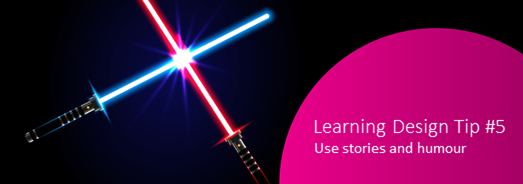A long time ago, in a galaxy far, far away, a Jedi and a learning designer walk into a bar …
Nothing captures attention like a good story. Storytelling is our native language, our way of connecting the dots, of learning ideas, of communicating and engaging. Stories and humour tap into our emotions and the feel-good endorphins that go with them, creating a positive affective learning environment, strengthening understanding and boosting memory.
At easyA, we love a good story and a bit of a laugh. There are five important guides to how we use them in learning design:
- Purpose focus – stories and humour need to be driven by the learning and performance objectives, not distracting from them. It can be too easy to throw in a story or funny line that may help with how people are feeling (which is important, we’ll come to that), but doesn’t add to the learning process.
- Know your audience – humour and stories are highly subjective. What you find funny may be cringy for others or at worst, offensive. You’re not designing for you, you’re designing for your client. Work by their standards and their culture (and their legal team!).
- Keep it relevant – basic adult learning principles dictate that your stories and humour need to be relevant, giving immediate application and connection to real-life experience. They need to tap into and reflect your audience experience, context and language.
- Keep it subtle – we’re not aiming for LOL, just a lightness of tone, a subtle quirkiness, a playful curiosity to make you smile and know that there was a human designing this learning, with other humans in mind as they did so. Skip the dad-jokes and sight-gags.
- Touch the heart – similar to the previous idea, we’re not aiming for gut-wrenching, tear-jerker, values-confronting levels of emotional depth. Just well-chosen, relevant stories to illustrate key points and build emotional engagement with elements of anticipation and surprise.
When it comes to the use of stories and humour in the design process, don’t just try.
Do, or do not (well, just do actually), there is no try.
Interested in a deep dive?
- Connie Malamed outlines her learning from an ‘Art of Storytelling’ presentation in The eLearning Coach
- Learn how to make change stick with storytelling and a story model in the article by Mick Mooney Making change stick storytelling
- In ‘Facts tell, stories sell’ Sharon Ferrier gives three great tips for corporate story development. Facts tell stories sell
- Christopher Pappas outlines the hurdles to jump when using humour in eLearning eLearning Industry
What will you do?
Put a post-it note on your desk, and write down the next three times you come across a story or the use of humour that you think contributes to the author’s objectives. Bringing stories and humour into your consciousness will improve your use of it as you design.
Get it touch!
Contact us at easyA to explore how our learning solutions design team can work with your organisation: www.easyauthoring.com

